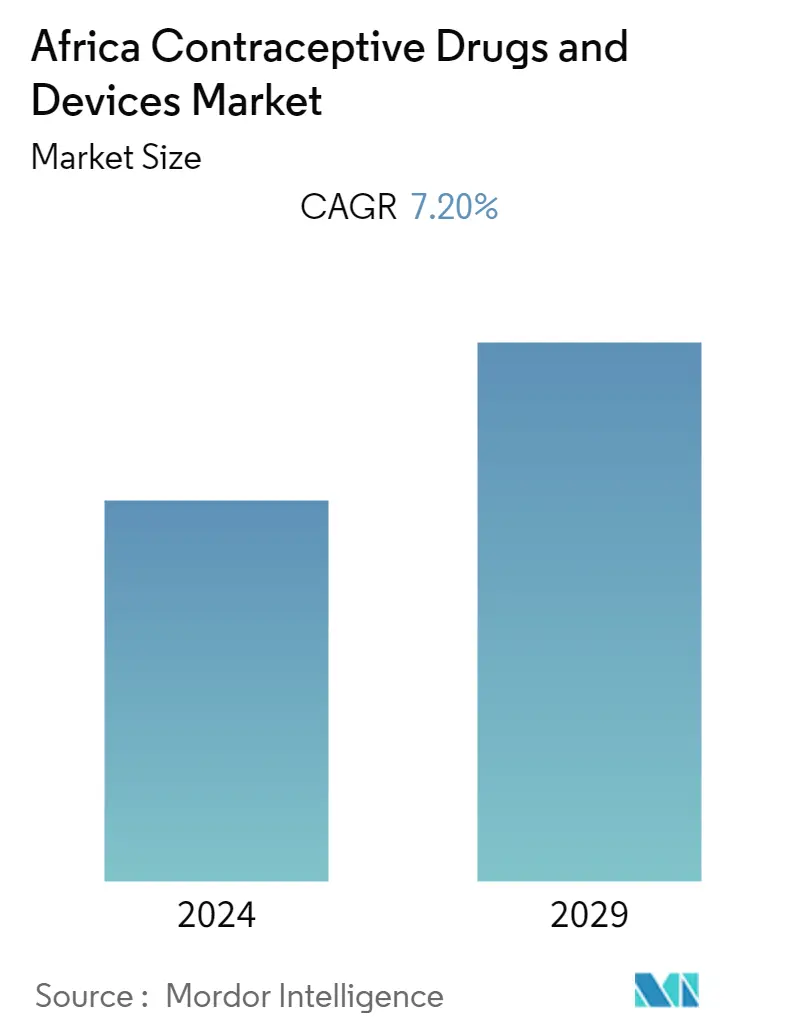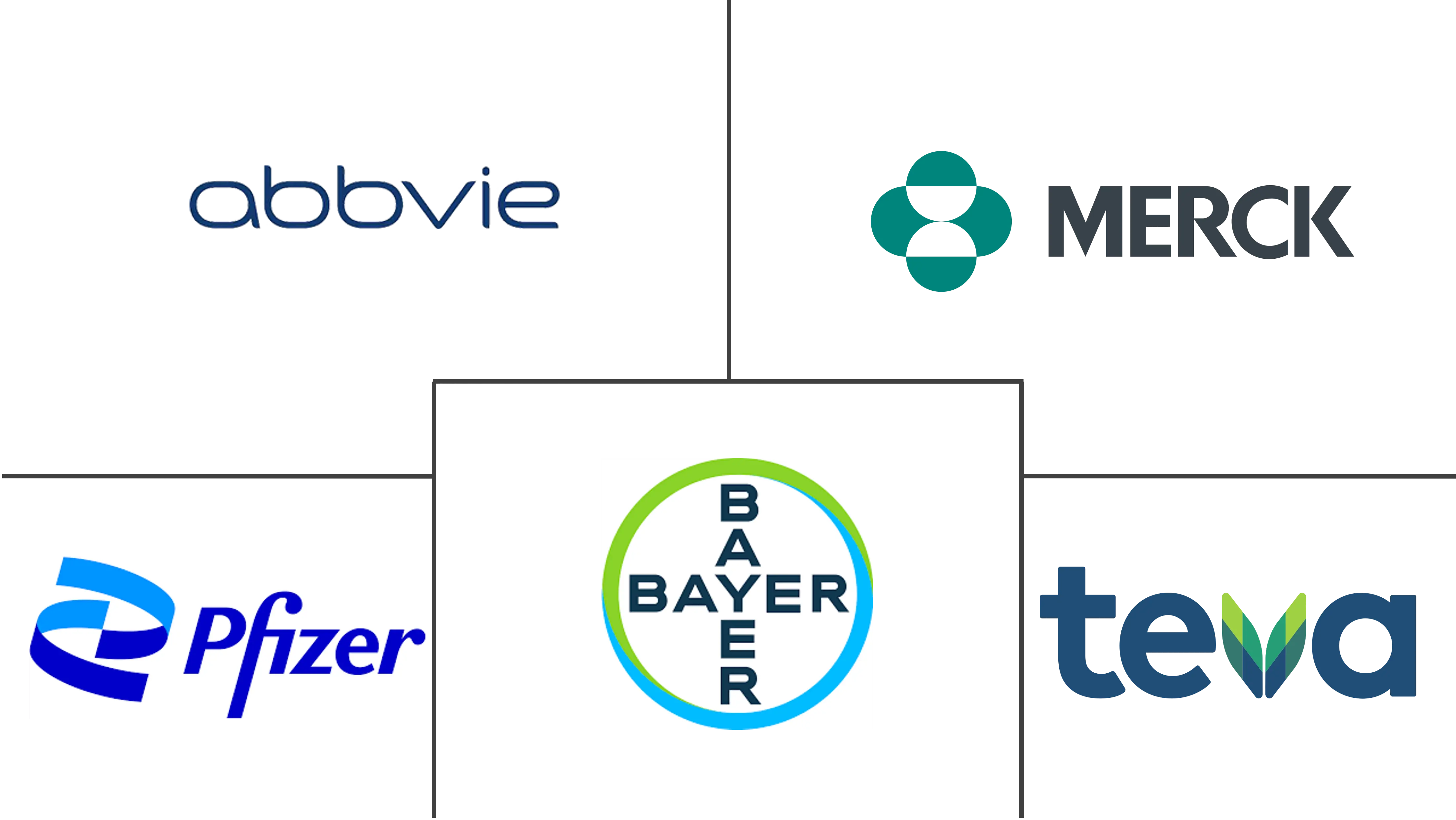Market Size of Africa Contraceptive Drugs and Devices Industry

| Study Period | 2019 - 2029 |
| Base Year For Estimation | 2023 |
| Forecast Data Period | 2024 - 2029 |
| Historical Data Period | 2019 - 2022 |
| CAGR | 7.20 % |
Major Players
*Disclaimer: Major Players sorted in no particular order |
Market Overview
The African contraceptive drugs and devices market is expected to register a CAGR of 7.2% during the forecast period.
The outbreak of the COVID-19 pandemic has pushed the healthcare industry into action, with a race to develop both therapeutic and preventive drugs. Exponentially increasing cases of the coronavirus worldwide are leading to the need for the development of novel treatments, with several clinical trials underway. Initially, the global COVID-19 outbreak and the lockdown scenario in various countries have imposed some challenges on the market, as hospitals and clinics were forced to suspend services to prevent the spread of the SARS-CoV-2 virus. The restrictions imposed by the government have significantly impacted the growth of the studied market during the initial period of the pandemic. As per the study published in August 2022 by the African Journal of Primary Health Care & Family Medicine, the COVID-19 pandemic aggravated the risk of sub-Saharan African women to HIV infection because of a multitude of factors, including child marriages, teenage pregnancies, dropping out of school, increase in the incidence of sexual and gender-based violence and reduced access to preventive and treatment services for HIV and sexually transmitted infections. In addition, the market growth is stabilizing in the current scenario after COVID-19 as the worldwide restrictions have eased down and various services have been resumed.
Certain factors propelling the market growth are increasing incidences of sexually transmitted diseases, an increasing rate of unintended pregnancies, and rising government initiatives.
An unintended pregnancy occurs from not using contraception or inconsistent and incorrect use of contraceptive methods. The growth of contraceptive markets is necessary to avoid unwanted pregnancies and their complications, especially in teenagers. Teenage pregnancy is a big problem in Africa. For instance, as per the data published by the UNFPA in June 2022, in Southern Africa, 65% of pregnancies were unintended, and 36% ended in abortion. The predominant cause of unintended pregnancy is sexual activity without effective contraception through choice or coercion. In many cases, unintended pregnancy is linked to gender-based violence, including early sexual debut that is non-consensual and child marriage. An increase in unplanned pregnancies has helped in the growth of the market.
In addition, the rising prevalence of sexually transmitted diseases among the population is expected to increase the market growth. For instance, the WHO estimates, updated in July 2021, that sub-Saharan Africa bears approximately 40% of the global burden of STIs. Additionally, as per the study published in April 2021, by BMC Public Health, STI prevalence was 7.7% and did not differ by HIV status. Prevalence differed by syndrome (3.5% vaginal discharge, 1.5% genital ulcer, 2.1% lower abdominal pain, 0.2% inguinal bubo). Thus, the rising burden of sexually transmitted diseases is expected to increase the demand for contraception to avoid getting diseases, thereby propelling market growth.
Moreover the products launches by the key players are expcted to boost thw growth of the market. For instrance, in March 2022, Medicines360, Population Services International, and Society for Family Health launched Avibela (levonorgestrel-releasing intrauterine system) 52 mg hormonal intrauterine device in Nigeria.
However, the high cost of devices and treatment and side effects associated with the use of contraceptive drugs and devices are some of the factors that are likely to impede market growth over the forecast period.
Scope of the Report
As per the report's scope, contraceptive drugs and devices are used for birth control. Contraception is more commonly known as fertility and birth control, described as the method to avoid pregnancy. Africa Contraceptive Drug and Devices Market is segmented by Products (Drugs and Devices) and Gender (Male and Female), and Geography (South Africa, Nigeria, Morocco, Uganda, Democratic Republic of the Congo, Rest of South Africa). The report offers the value (in USD million) for the above segments.
| By Products | |||||||||
| |||||||||
|
| By Gender | |
| Male | |
| Female |
| Geography | |
| South Africa | |
| Nigeria | |
| Morocco | |
| Uganda | |
| Democratic Republic of the Congo | |
| Rest of South Africa |
Africa Contraceptive Drugs and Devices Market Size Summary
The African contraceptive drugs and devices market is poised for significant growth, driven by a combination of factors including the rising incidence of unintended pregnancies and sexually transmitted diseases. The market is experiencing a resurgence following the challenges posed by the COVID-19 pandemic, which initially disrupted healthcare services and impacted market expansion. However, as restrictions have eased and services resumed, the market is stabilizing. The prevalence of unintended pregnancies, particularly among teenagers, and the high burden of sexually transmitted infections in sub-Saharan Africa are key drivers of demand for contraceptive solutions. Government initiatives and increased awareness about contraceptive options are further propelling market growth, as evidenced by recent product launches and campaigns aimed at enhancing contraceptive uptake.
The market landscape is moderately competitive, with both local and international players such as Allergan PLC, Bayer AG, Johnson & Johnson, and others actively participating. These companies are introducing innovative products to meet the growing demand for effective contraceptive methods. Despite the high cost of some devices and potential side effects associated with contraceptive use, the market is expected to expand due to the increasing need for contraception to prevent unintended pregnancies and manage sexual health. The rising contraceptive prevalence rate, particularly in regions like South Africa, underscores the market's potential for growth, as more women seek modern contraceptive methods to address their reproductive health needs.
Africa Contraceptive Drugs and Devices Market Size - Table of Contents
-
1. MARKET DYNAMICS
-
1.1 Market Overview
-
1.2 Market Drivers
-
1.2.1 Increasing Incidence of the STDs and Unplanned Pregnancies
-
1.2.2 Rise in Government Initiatives
-
-
1.3 Market Restraints
-
1.3.1 Side Effects Associated with the Use of Contraceptive Drugs and Devices
-
-
1.4 Porter's Five Forces Analysis
-
1.4.1 Threat of New Entrants
-
1.4.2 Bargaining Power of Buyers/Consumers
-
1.4.3 Bargaining Power of Suppliers
-
1.4.4 Threat of Substitute Products
-
1.4.5 Intensity of Competitive Rivalry
-
-
-
2. MARKET SEGMENTATION (Market Size by Value in USD million)
-
2.1 By Products
-
2.1.1 By Drugs
-
2.1.1.1 Oral Contraceptives
-
2.1.1.2 Topical Contraceptives
-
2.1.1.3 Contraceptive Injectable
-
-
2.1.2 By Device
-
2.1.2.1 Condoms
-
2.1.2.2 Diaphragms
-
2.1.2.3 Cervical Caps
-
2.1.2.4 Sponges
-
2.1.2.5 Vaginal Rings
-
2.1.2.6 IUD
-
2.1.2.7 Other Devices
-
-
-
2.2 By Gender
-
2.2.1 Male
-
2.2.2 Female
-
-
2.3 Geography
-
2.3.1 South Africa
-
2.3.2 Nigeria
-
2.3.3 Morocco
-
2.3.4 Uganda
-
2.3.5 Democratic Republic of the Congo
-
2.3.6 Rest of South Africa
-
-
Africa Contraceptive Drugs and Devices Market Size FAQs
What is the current Africa Contraceptive Drugs and Devices Market size?
The Africa Contraceptive Drugs and Devices Market is projected to register a CAGR of 7.20% during the forecast period (2024-2029)
Who are the key players in Africa Contraceptive Drugs and Devices Market?
Bayer AG, Merck & Co. Inc., Pfizer Inc., Teva Pharmaceutical Industries Ltd. and AbbVie are the major companies operating in the Africa Contraceptive Drugs and Devices Market.

